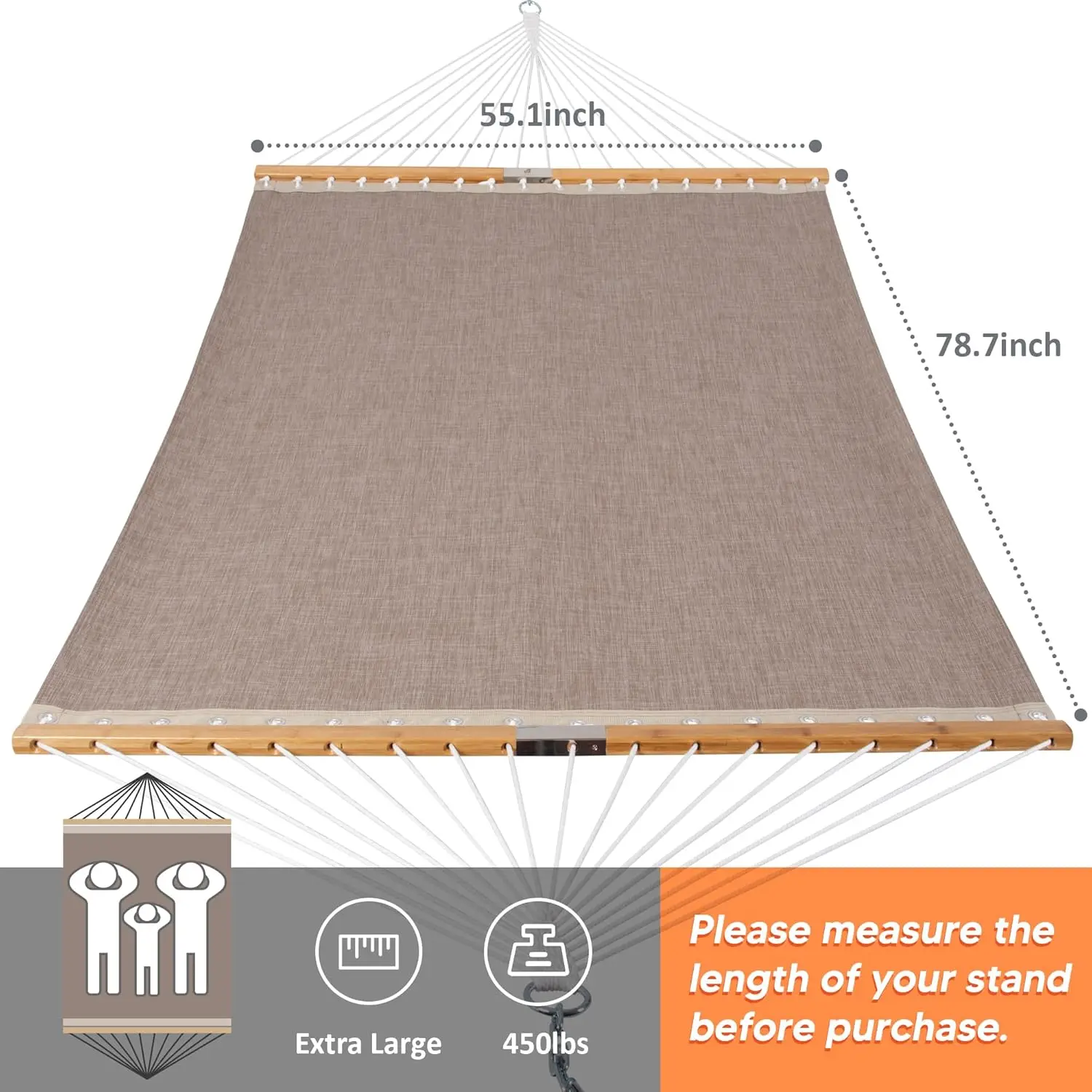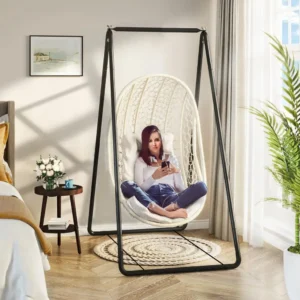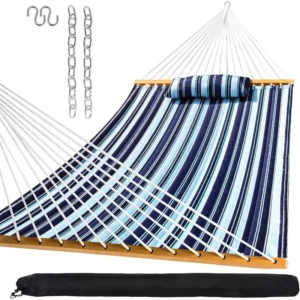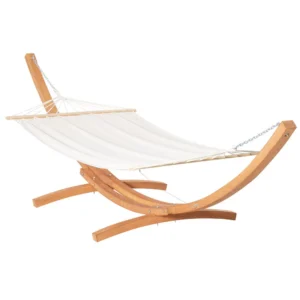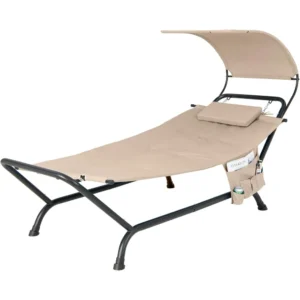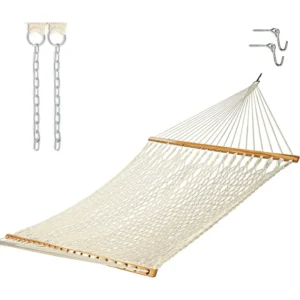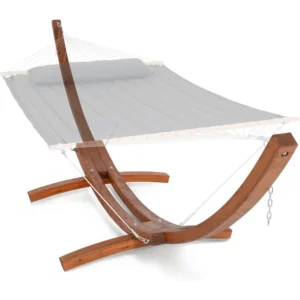Introduction: What Makes Traditional Rope Hammocks Timeless
Traditional rope hammocks represent one of the most iconic and enduring outdoor comfort innovations ever created. With their distinctive open weave patterns and sturdy spreader bars, these hammocks create a flat, supportive surface that has delighted loungers for generations. Their design traces back centuries, evolving from practical sleeping solutions into beloved symbols of leisure and relaxation.
What makes rope hammocks stand apart from other styles is their perfect combination of:
- Classic open weave construction that promotes airflow
- Spreader bars that create easy entry and a stable, flat surface
- Distinctive rope texture that contours to your body
- Timeless aesthetic that complements virtually any outdoor setting
- Exceptional durability when crafted with quality materials
The enduring popularity of rope hammock sets isn’t merely about nostalgia—it’s about a time-tested design that continues to deliver unmatched comfort and relaxation. In this guide, we’ll explore the key features that distinguish premium rope hammocks from basic options, helping you make an informed choice for years of outdoor enjoyment.
Understanding Your Hammock Needs: Matching Features to Lifestyle
Before diving into specific features, consider how your lifestyle and environment will impact your ideal rope hammock choice:
- Usage frequency: Daily relaxation demands more durable materials than occasional use
- Location: Indoor placement allows for softer, less weather-resistant materials, while uncovered outdoor areas require highly durable synthetics
- Climate considerations: Coastal environments with high humidity and salt exposure need corrosion-resistant hardware and mildew-resistant ropes
- Available space: Consider whether you’ll hang between trees, posts, or need a dedicated stand
- Occupancy needs: Single loungers can choose smaller hammocks, while couples should opt for double or queen sizes
- Budget expectations: Quality rope hammocks typically range from $80 for basic models to $300+ for premium versions
Your specific indoor or outdoor hammock placement will significantly impact material choices. For example, a covered porch allows more material flexibility than a fully exposed poolside location. Understanding your environment helps you select the perfect combination of comfort and durability.
When selecting your hammock, also consider the best indoor and outdoor hammock locations available to you, as this will influence the features you should prioritize.
Rope Materials: The Foundation of Comfort and Durability
The rope material forms the foundation of your hammock’s performance, directly affecting comfort, weather resistance, maintenance needs, and overall lifespan. Let’s explore the primary options and their distinctive characteristics.
| Material Type | Comfort/Softness | Durability | Weather Resistance | Maintenance Needs | Approx. Lifespan |
|---|---|---|---|---|---|
| Cotton Rope | ★★★★★ | ★★★ | ★★ | High | 4-7 years |
| Polyester Rope | ★★★★ | ★★★★ | ★★★★ | Low | 7-10 years |
| Premium Synthetics | ★★★★★ | ★★★★★ | ★★★★★ | Very Low | 10+ years |
Understanding these differences helps you balance comfort priorities with practical considerations like weather exposure and maintenance commitment.
Cotton Rope: The Classic Choice
Cotton rope represents the original rope hammock material, beloved for its exceptional comfort characteristics:
- Unmatched softness against skin, creating a gentle, natural feel
- Superior breathability that keeps you cool during hot weather
- Natural flexibility that contours perfectly to body shape
- Classic appearance with traditional aesthetics
However, cotton’s natural comfort comes with maintenance considerations:
– Requires indoor storage during extended wet weather
– Susceptible to mildew and mold in humid environments
– May gradually stretch and sag over time
– Typically needs replacement after 4-7 years with regular use
Cotton excels in covered areas like porches, sunrooms, or seasonal use with proper storage. Many hammock enthusiasts feel the superior comfort justifies the additional care requirements.
Polyester Rope: The Durable Alternative
Polyester rope emerged as an ideal middle ground, offering improved durability while maintaining good comfort:
- Excellent resistance to UV damage and fading
- Naturally repels moisture, mold, and mildew
- Maintains tension with minimal stretching or sagging
- Requires little maintenance beyond occasional cleaning
- Typically lasts 7-10 years even with regular outdoor use
While slightly firmer than cotton initially, polyester softens with use while maintaining its structural integrity. Its practical benefits make it ideal for:
– Uncovered outdoor locations
– Humid or coastal environments
– Low-maintenance preferences
– Year-round outdoor exposure
For many users, polyester’s durability advantages outweigh the minor comfort differences compared to cotton.
Premium Synthetic Ropes: The Best of Both Worlds
Advanced synthetic ropes like DuraCord® represent the pinnacle of hammock technology, engineered to offer:
- Cotton-like softness with superior strength
- Solution-dyed colors that resist fading even in harsh sunlight
- Complete resistance to rot, mildew, and staining
- Minimal maintenance requirements with simple cleaning
- Extended lifespan of 10+ years in outdoor conditions
While premium synthetics typically command higher prices, their advantages include:
– Set-and-forget convenience with minimal care needs
– Ideal performance in challenging environments like saltwater exposure
– Superior long-term value through extended lifespan
– Consistent comfort throughout years of use
These advanced materials have largely solved the traditional cotton vs. durability compromise, though at a higher initial investment.
Proper hammock installation and safety considerations are essential regardless of material choice, ensuring your rope hammock provides years of safe enjoyment.
Construction Quality: What Separates Premium from Basic
Beyond material selection, construction techniques dramatically impact a rope hammock’s comfort, durability, and overall value. Premium rope hammocks typically feature:
- Hand-crafted weaving that ensures consistent tension and pattern
- 3-ply rope construction for superior strength and durability
- Higher rope count for better weight distribution and support
- Reinforced attachment points that resist wear and stress
- Marine-grade hardware that resists corrosion
- Carefully finished edges to prevent unraveling
Visual quality indicators include perfectly even patterns, consistent tension throughout the weave, and symmetrical construction with no irregular gaps. These details reflect craftsmanship that directly translates to comfort and longevity.
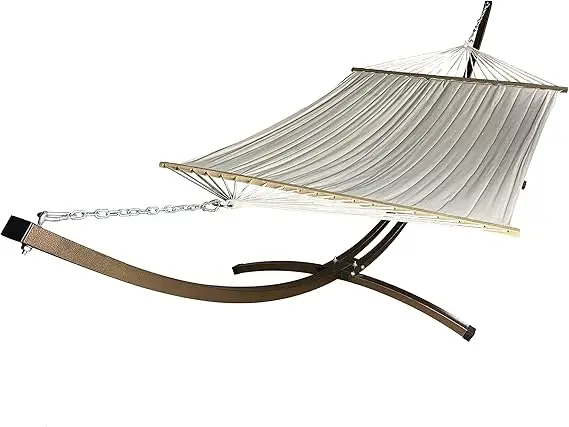
Spreader Bar Design and Materials
Spreader bars serve as the structural framework of traditional rope hammocks, playing a crucial role in both form and function:
- Keep the hammock bed open and flat for easy entry and exit
- Provide stability and prevent excessive wrapping
- Create the classic rope hammock silhouette
- Distribute weight evenly across the rope bed
Quality spreader bars typically feature:
– Premium hardwoods like oak, ash, or tropical cumaru
– Weather-resistant varnish or oil treatments
– Proportional sizing (24-60 inches wide depending on hammock size)
– Smooth, rounded edges to protect the rope and users
– Proper curvature that balances stability with comfort
The materials used in spreader bar hammocks significantly impact both durability and aesthetics. Well-crafted hardwood spreader bars may require occasional refinishing but can last decades with proper care, often outlasting multiple rope beds.
Weave Patterns and Rope Configuration
The specific weave pattern dramatically affects both comfort and durability:
- Traditional diamond patterns create optimal weight distribution
- Tighter weaves offer more support but less airflow
- Looser weaves maximize breathability but may leave imprints
- Hand-woven hammocks typically feature more consistent tension
- Proper hole sizing (1-2 inches) balances support and comfort
The number of horizontal support ropes directly impacts weight capacity and longevity. Premium hammocks typically feature more support ropes with reinforced edges to prevent stretching and maintain shape over time.
The connection points where ropes meet spreader bars receive the greatest stress, making their construction particularly important. Look for reinforced wrapping techniques that distribute weight evenly and resist wear.
Hardware and Attachments: The Unsung Heroes
While less visible than the hammock bed itself, hardware components critically impact safety, durability, and user experience:
- Suspension chains or ropes connect the hammock to hanging points
- End rings or O-rings join the rope bed to the suspension system
- Hooks or carabiners attach to hanging points or stands
- Hardware material quality directly affects safety and longevity
Premium hammocks typically feature:
– Marine-grade stainless steel or zinc-plated hardware
– Weight ratings that exceed the hammock’s capacity (typically 450-600 lbs)
– S-hooks with safety closures to prevent accidental detachment
– Welded (rather than bent) rings for superior strength
Many rope hammock owners discover that leaving hammocks outside can rapidly degrade hardware components, making quality materials particularly important for outdoor installations.
Size and Capacity: Finding Your Perfect Fit
Selecting the right hammock size ensures optimal comfort and safety:
| Size | Typical Dimensions | Weight Capacity | Best For | Hanging Distance |
|---|---|---|---|---|
| Single | 4.5’ x 11’ | 275-350 lbs | Individual adults | 12-14 feet |
| Double | 5’ x 13’ | 400-450 lbs | Couples or parent with child | 14-16 feet |
| Queen/Family | 6’ x 13’+ | 500-600 lbs | Multiple users or larger individuals | 15-17 feet |
When considering size, remember:
– Wider hammocks provide more flat space for diagonal lying
– Longer hammocks accommodate taller individuals more comfortably
– Weight capacity should include a safety margin beyond user weight
– Larger hammocks require more hanging space and stronger support
For couples or families, double or two-person hammock sets provide the ideal dimensions for shared relaxation while maintaining proper support and comfort.
Comfort Features: Beyond the Basics
The ultimate test of any hammock is the comfort experience it delivers. Several factors contribute to superior comfort in traditional rope hammocks:
- Body contouring that creates a “floating” sensation without pressure points
- Diagonal lying position (30-45 degrees from center) for flattest, most supportive surface
- Open weave design that maximizes airflow on hot days
- Proper tension that prevents excessive sagging while allowing natural give
- Edge stability that makes entry and exit easier
Optional accessories can enhance comfort further:
– Dedicated hammock pillows with weather-resistant materials
– Quilted pads that reduce rope imprints on skin
– Weather-resistant cushions for extended lounging
– Canopies or stands with sun protection features
The perfect balance between support and flexibility creates the distinctive comfort rope hammocks are known for, adapting to your body while providing necessary structure.
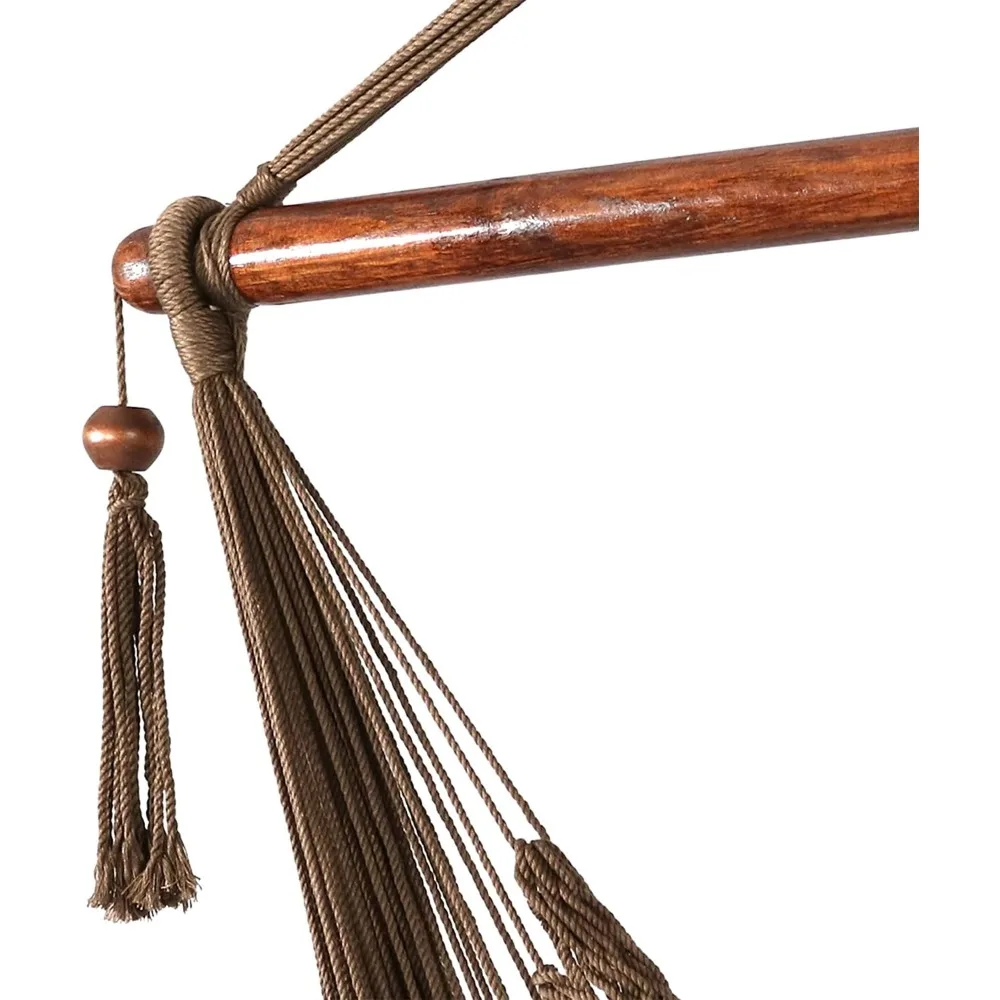
Installation and Hanging: Setting Up for Success
Proper installation dramatically impacts both comfort and safety:
- Ideal hanging height is 18-24 inches from ground when weighted
- Optimal hanging distance equals hammock length plus 2-3 feet
- Proper tension creates a 30-degree angle from horizontal when unoccupied
- Secure attachment points should support at least twice the weight capacity
- Even tension on both sides ensures balanced weight distribution
Common installation mistakes include:
– Hanging too tight (creates unstable, tippy experience)
– Hanging too loose (causes excessive sagging)
– Uneven height at attachment points (creates sliding)
– Insufficient support strength (risking failure)
Many rope hammock enthusiasts prefer framed hammocks with spreader bars for their stability and ease of setup, eliminating the need for perfectly positioned trees or posts.
Durability and Maintenance: Protecting Your Investment
Proper maintenance significantly extends hammock lifespan:
| Season | Cotton Rope Care | Synthetic Rope Care | Hardware Care |
|---|---|---|---|
| Spring | Gentle wash with mild soap, thorough drying | Rinse with garden hose | Check for rust, lubricate moving parts |
| Summer | Bring inside during extended rain, spot clean | Occasional rinse to remove debris | Verify secure connections |
| Fall | Deep clean before storage, ensure completely dry | Clean with mild soap solution | Inspect for wear or damage |
| Winter | Store indoors in dry location | Can remain outdoors in mild climates | Apply protective coating if needed |
For all rope hammocks:
– Address stains promptly before they set
– Keep spreader bars refinished to prevent wood degradation
– Inspect ropes regularly for wear, especially at connection points
– Replace individual ropes if possible when damage occurs
– Store in dry location when not in use for extended periods
These simple maintenance routines can double or triple your hammock’s useful lifespan.
A-Frame Stand Hammock Sets, Swinging Hammock Chair Sets
$154.62 Select options This product has multiple variants. The options may be chosen on the product pageClassic Wooden Stand Hammock Sets, Heavy Duty Hammock Sets
$1,061.68 Select options This product has multiple variants. The options may be chosen on the product pageHammock Sets with Canopy, Heavy Duty Hammock Sets
$286.31 Select options This product has multiple variants. The options may be chosen on the product pageDouble / Two Person Hammock Sets, Rope Hammock Sets
Double Traditional Cotton Rope Hammock with Extension Chains – 450 lbs Capacity for Backyard & Patio$292.98 Select options This product has multiple variants. The options may be chosen on the product pageHeavy Duty Hammock Sets, Wooden Arc Stand Hammock Sets
$878.66 Select options This product has multiple variants. The options may be chosen on the product page
Weather Resistance: Battling the Elements
Environmental factors present significant challenges to rope hammock durability:
- UV exposure gradually weakens fibers (cotton degrades 30-50% faster than polyester)
- Rain promotes mildew and rot, particularly in cotton
- Humidity accelerates mold growth in natural fibers
- Temperature fluctuations stress attachment points through expansion and contraction
- Salt air corrodes standard hardware (requires marine-grade alternatives)
Protective strategies include:
– Using hammock covers when not in use
– Selecting appropriate materials for your climate
– Installing in partially shaded areas to reduce UV exposure
– Proper storage during off-seasons or severe weather
– Regular cleaning to remove environmental contaminants
Understanding your specific environmental challenges helps select the most comfortable hammock type for your situation, balancing ideal comfort with practical durability.
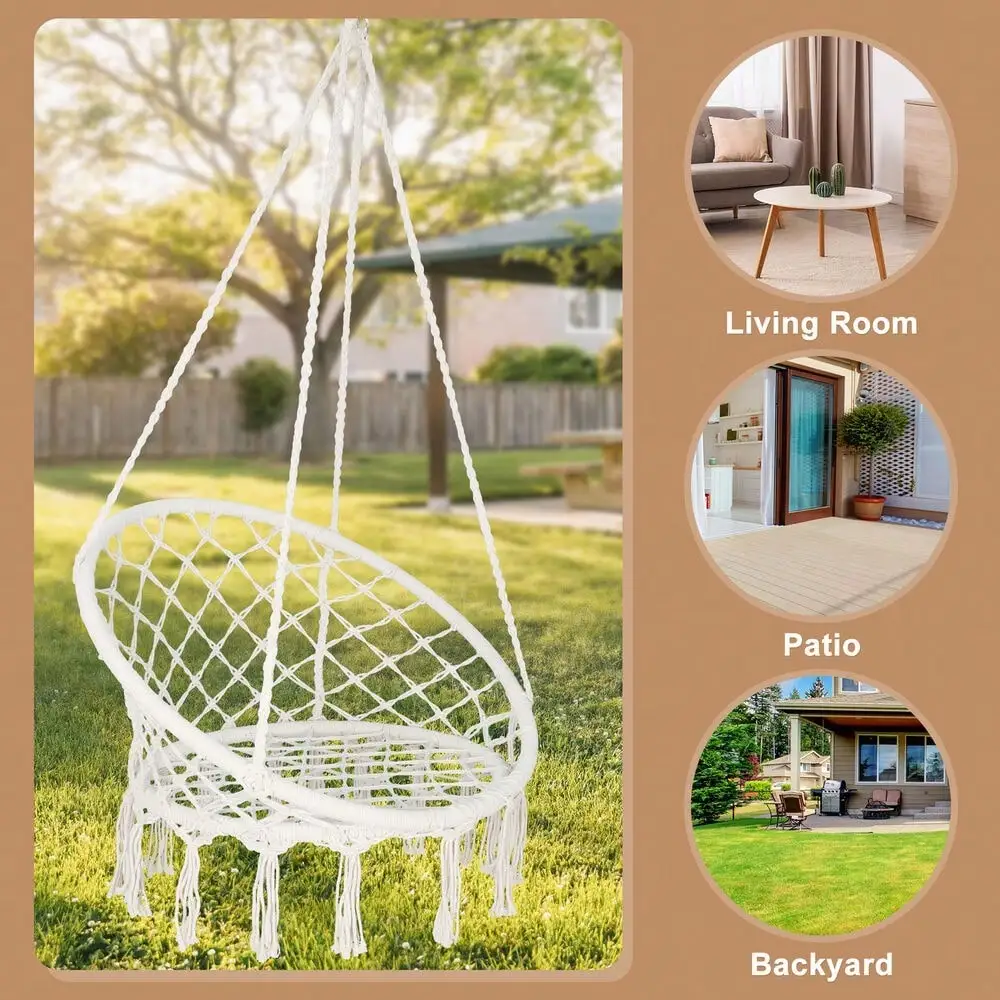
Safety Considerations: Relaxing with Peace of Mind
Safety should never be compromised when selecting and installing a rope hammock:
- Always respect weight capacity limits (including combined weight of all users)
- Inspect ropes and hardware regularly for wear, fraying, or corrosion
- Enter and exit slowly from the side, not the ends
- Keep hammocks away from fire pits, grills, or other heat sources
- Supervise young children as weave patterns can create entrapment hazards
- Ensure hanging points are structurally sound (trees, posts, or stands)
Warning signs that indicate replacement or repair needs:
– Multiple broken or frayed ropes
– Visible corrosion on hardware components
– Cracked or splintered spreader bars
– Excessive sagging that doesn’t recover
– Attachment hardware that shows deformation
Regular inspection takes just moments but prevents accidents and extends hammock life.
Are Traditional Rope Hammocks Worth the Investment?
When considering value, several factors support investing in quality rope hammocks:
Pros:
– Superior comfort compared to many modern alternatives
– Distinctive aesthetic that enhances outdoor spaces
– Excellent durability when quality materials are selected
– Ability to replace rope beds while keeping frames and hardware
– Timeless design that doesn’t become dated
Considerations:
– Higher maintenance needs than solid-fabric alternatives
– Initial cost higher for premium versions ($150-300+)
– Requires proper installation for optimal experience
– Weather limitations depending on material selection
For most users, the cost-per-use calculation strongly favors quality rope hammocks. A premium model costing $250 that lasts 10 years with regular use provides relaxation at just $25 per year—outstanding value for daily comfort and enjoyment.
Complete hammocks and stands often represent the best value by providing perfectly matched components designed to work together.
How Do Traditional Rope Hammocks Compare to Other Styles?
Understanding the distinctive benefits of rope hammocks compared to alternatives helps make informed choices:
| Feature | Rope Hammocks | Quilted Hammocks | Brazilian/Fabric Hammocks | Camping Hammocks |
|---|---|---|---|---|
| Comfort | Contours to body with firm support | Padded with less conforming | Enveloping with minimal structure | Minimal padding, designed for portability |
| Breathability | Excellent airflow | Limited breathability | Moderate airflow | Good airflow |
| Durability | 5-10+ years depending on material | 3-7 years typically | 5-8 years with proper care | 3-5 years with outdoor use |
| Weather Resistance | Varies by material | Good with proper materials | Moderate, needs protection | Excellent (designed for outdoors) |
| Ease of Entry | Moderate (spreader bars help) | Easy (structured surface) | More difficult (wraps around user) | More difficult (requires technique) |
| Price Range | $80-300+ | $100-250 | $50-200 | $40-200 |
Rope hammocks excel when:
– Maximum breathability is needed for hot climates
– Traditional aesthetic is desired
– Firm but conforming support is preferred
– Longevity is a priority with proper care
Other styles may better serve specific needs like ultimate portability, full weather exposure, or padded support.
What Are Common Myths About Traditional Rope Hammocks?
Several misconceptions prevent people from experiencing the joy of traditional rope hammocks:
Myth: Rope hammocks always leave uncomfortable marks on skin
Fact: Quality rope hammocks with proper tension and diagonal lying position minimize imprinting. Premium materials and proper technique largely eliminate this issue.
Myth: Traditional rope hammocks tip over easily
Fact: Properly installed rope hammocks with correctly positioned spreader bars offer excellent stability. Most tipping incidents result from improper entry technique or installation.
Myth: Cotton rope hammocks require too much maintenance
Fact: While cotton does require more care than synthetics, basic seasonal maintenance is sufficient for many users. Modern synthetic alternatives also eliminate most maintenance concerns.
Myth: All synthetic rope feels artificial and uncomfortable
Fact: Premium synthetic materials like DuraCord® have achieved remarkable softness that rivals or exceeds cotton while adding superior durability and weather resistance.
Myth: Rope hammocks can’t be left outside
Fact: While cotton rope hammocks have outdoor limitations, polyester and premium synthetic versions are specifically designed for year-round outdoor use with minimal maintenance.
Understanding these realities helps overcome hesitations about embracing the unmatched relaxation experience that quality rope hammocks provide.

